Safety advice for plein air painters that could save your life > Get expert tips from a Chicago artist on how plein air painters can be safe while painting outdoors in public spaces.
Plein Air Painting and Personal Safety
by Mary Longe
(organizer of the Plein Air Painters Chicago)
In 2018, Plein Air Painters Chicago (PAPC) scheduled a paint out for our city’s iconic Buckingham Fountain, a favorite scene for our members and practically any movie or TV show set here. It sits on a stretch of Grant Park in view of Lake Michigan, on the East side of the Loop, and a stone’s throw from the Art Institute, Pritzker Pavilion, and “the Bean.”
Basically, the fountain is on the foot path of tourists and locals in every season. When we schedule PAPC paint outs, we check calendars for the Park District, music festivals, fun runs and art fairs – the usual groups that schedule events that often cause havoc to transportation, parking, and restrooms for our paint outs. We were confident that we’d found a Saturday morning devoid of conflicts.
Unfortunately, a new event appeared out of thin air. Literally. Pokémon Go Live. Gamers were like live pinball players bumping into easels, artists, and equipment while collecting their Pokémon. You can do everything to make sure plein air is fun and safe, but sometimes a paint out sends you unforeseen, invisible Japanese monsters and their captors to battle.
On a More Serious Note
In Chicago, we also battle the reality and the perception of more serious personal safety concerns. It’s no secret that our city has a reputation for a high count of murders and other crime. Heck, before Michael Jordon eclipsed him, Al Capone, the mobster, was the poster child for our city throughout the world.
Even our nickname, “City of Big Shoulders,” reminds us that we can handle ourselves and others. Following PAPC’s last paint out, however, at the End of Season 2021 Debrief and Pizza Party, we heard that sense of bravado wane. Paint out attendance for some members is dependent on their sense of safety.
Reactions to the initial statement suggested that this was simply a suburban perception and city dwellers knew better, but the subject surfaced two more times during the informal focus group. Eventually, even locals fessed up to similar concerns, though they were quick to counter with civic pride and suggestions to enable personal safety. It’s impossible to ignore the epidemic of car jackings and muggings that’s broken out since the pandemic began. They happen during daylight hours, in all neighborhoods, and at gas stations and ATMs. Happily, we found consensus during our meeting in wanting to continue paint outs in view of potential dangers. The solution was for the group and the individuals to put precautions into place.
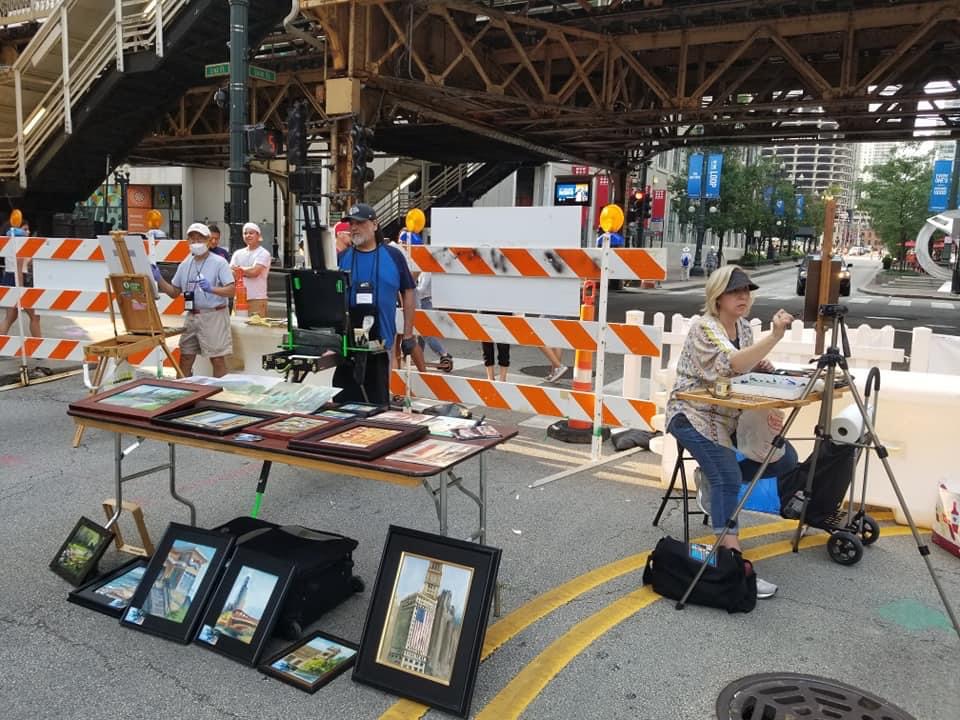
Questions to Ask Yourself About Safety While Painting en Plein Air
When it all boils down, a sense of safety in the streets is in the heart of the individual person. For example, how are you emotionally when it comes to feeling safe or fearful? What makes you shiver most … bodily harm, losing your belongings, or hurtful words? Do you “trust your gut” or ignore your instincts when you get a feeling that something is amiss? Psychologically, do you have a track record for reading situations and people accurately? Does your physicality offer defense? What would you do if you were faced with a dangerous situation? Are you small and agile or loud and intimidating? Are you able to run, scream, or fight back? Awareness of our fears and our defenses helps determine what we need to feel and be safer in any situation.
There are many personal safety general resources as close as Google. Amazon carries all kinds of personal safety items. Here are a few ideas specific for plein air painters.
Packing for Plein Air – Things to Carry
We outdoor artists are unlikely to add more to our bags, but here are a few small items you might consider including on your packing list. In fact, if you’re serious about personal safety, you’ll keep them close in a pocket on your person, not in the bottom pocket under your view finder, behind your protein bar from last year.
- Fully charged cell phone and portable charger to ensure you can call for help
- Whistle on a lanyard or key ring (PAPC provided whistles with compasses to members, some of us get into trouble with directions to paint outs.)
- Pepper spray, to give enough time to abandon a scene and seek help
- Personal alarm/siren to create a diversion and deter an attack – some are sold with pepper spray
- What not to carry? A purse – place keys and money in a pocket.
Preparing for a Paint Out
Whether painting with a formal group, with friends or by yourself, here are few things to consider.
- Safety in numbers – Find a paint and/or commuting buddy. You don’t need to paint the same scene, but make an arrangement to be in sight of each other. Exchange phone numbers.
- If multiple people are painting together, pinpoint exactly where to meet. The goal is to walk directly to the spot and eliminate anyone wandering and searching.
- Research the location before you leave home. Google the address. Check it out on Google Earth and see what’s around. What’s open when you’ll be there?
- What’s the walk like from public transportation or parking to the site? Does a little longer distance offer more foot traffic or lighting – especially for nocturne settings? Though people are coming from different directions, arrange to meet up with someone at the public transportation stop to go the rest of the way to the paint out.
- If you have a car, offering a ride to and from public transportation is a gift for those lugging their kits. Help keep them safe.
- There are a variety of apps available to help people communicate. Some track and pinpoint on a map where people are located. The PAPC steering team decided against the mapping because the apps aren’t secure and the worry was that people could be targeted. We are looking to offer people an opportunity to plug into a group on What’s App so that people are more likely to find each other in paint out locations where there are multiple entrances or confusing signage.
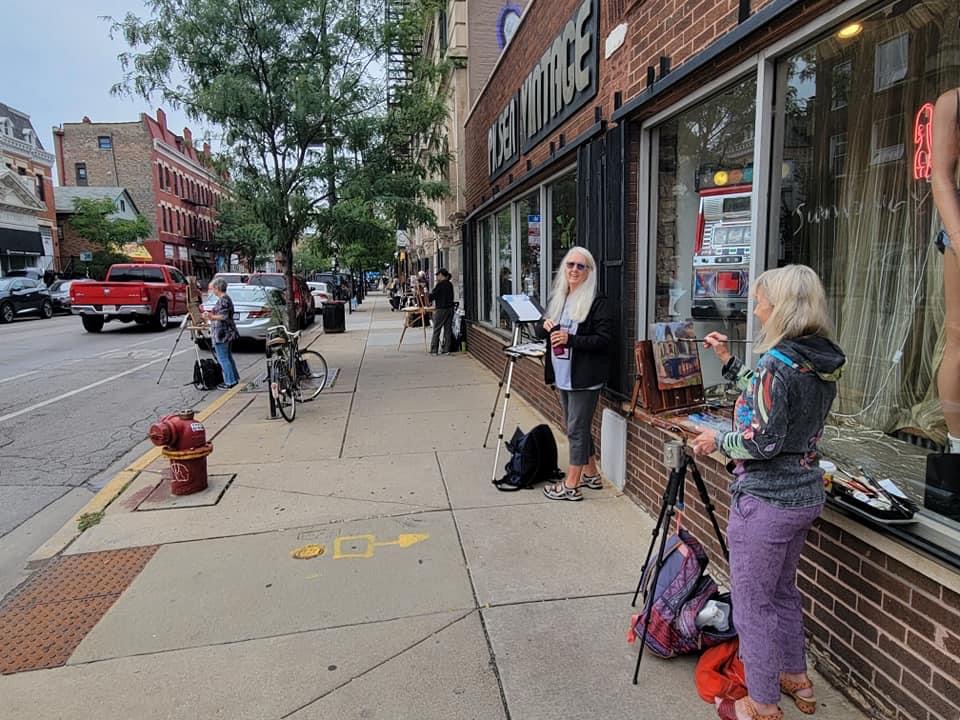
Staying Safe At the Paint Out
Once you are onsite, you want to attend to painting. Here are a few things you can do to reduce your vulnerability to harassment or a mugging.
- Don’t trust your treasures to anyone else. First, determine what are your treasures – the essentials you must not lose. Your whole kit is not the treasure. Asking someone to watch your belongings is trusting your treasures to someone else. Most items can be replaced, at least functionally. Your keys and money might be considered treasures, put them in your pocket, not in your kit. Don’t bring anything with you that you absolutely cannot lose.
- Find your scene, then do a 360-degree twirl. Most important, did you find a better scene? (Trick question.) Assess your surroundings – anything or anyone feel threatening? Pay attention to what feels threatening.
- Setting up your easel – Do you have a way to escape if someone enters your space? Where would you go if needed? Move your backpack under your easel so you or anyone else can’t trip on it or swipe it. Being up against a wall can offer safety from someone approaching from behind. As a painter however, you may want to angle yourself so you can back up to check the development of your work. If you do have a practice of backing away to look at your painting, also use the opportunity to check your surroundings.
- Can you see your painting buddy? Make a plan if one of you needs to leave your easels. Would you feel safer if you left your brushes or backpack with them? Do it if the answer is yes.
- Share code words, like “walnut oil” to use if you want your buddy to pay closer attention to a visitor you have, and “stand oil,” for instance, if you’re feeling threatened. The question, “Hey, Barb, do you have any walnut oil?” should bring you some useful attention from your buddy, Barb. “Barb, I need stand oil,” could be code to dial 911.
- When you have a sense that something bad might happen, start preparing the outcome. Calling out to your buddy, picking up your bag and brushes and running, handing over your bag, setting off your personal alarm, getting pepper spray ready for use. Be alert and ready.
- Interruptions from the public are some artist’s thorns and other artist’s roses. If you wear earbuds to deter interruptions, don’t turn on the music or podcast. If you must have a vibe, keep it at dog-whistle low levels so you can also hear your surroundings.
- Keeping onlookers at a safe distance became critical during the pandemic. As a group, PAPC made T-shirts that said on the back, “My Painting Looks Best from 6 Feet Away.” One artist made signs requesting space and posted it on their backpack. To mark off a distance, another artist used bright orange traffic cones, sold as soccer goals, purchased for a few bucks at the Dollar Store. When you need space, communicate it one way or another. If necessary, don’t be afraid to say it directly, politely, and with conviction to someone lurking. Or tell Barb to send in the stand oil.
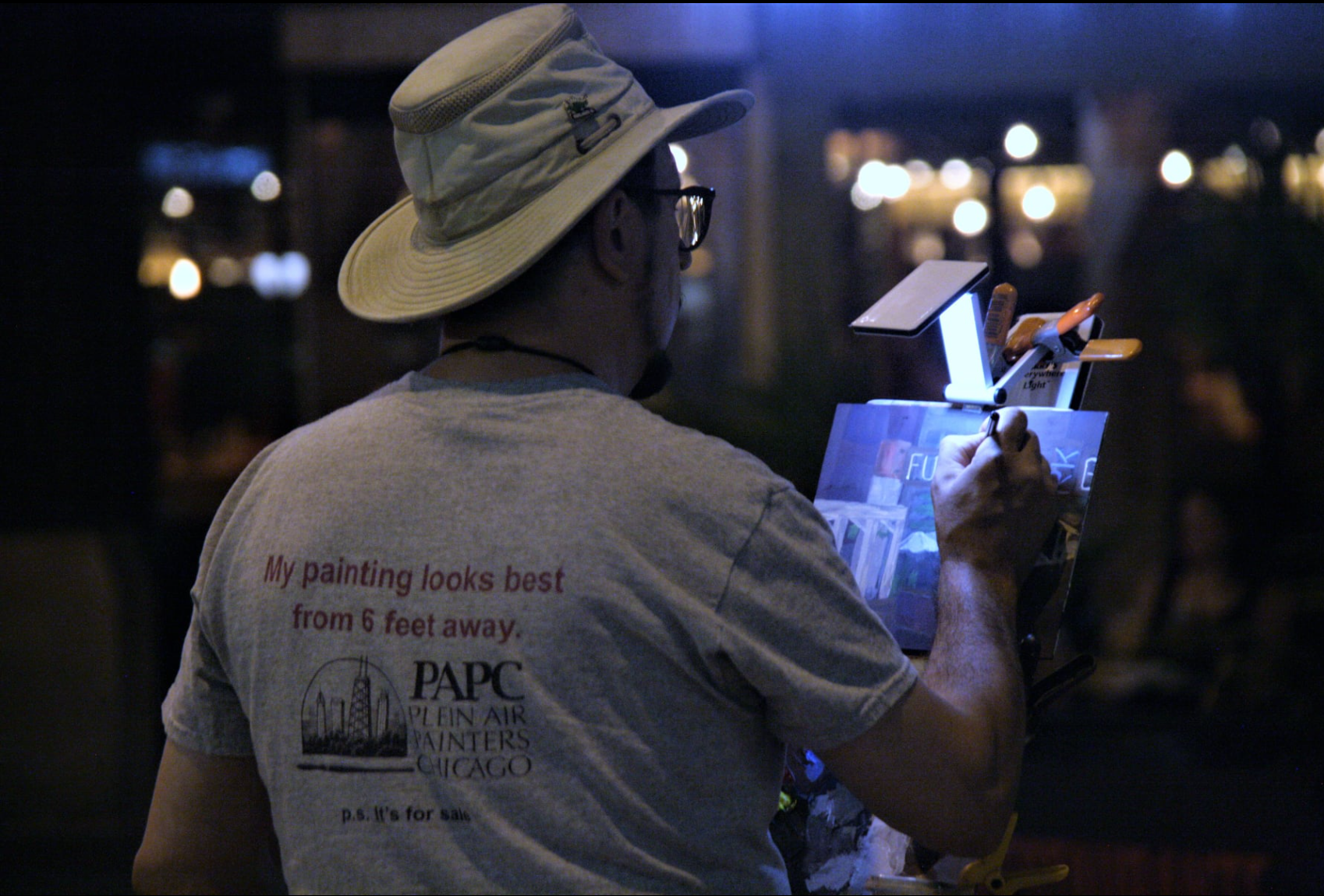
Handling Financial Transactions
Don’t accept cash on the street. Use Zelle, PayPal, Square, or the like to handle transactions.
Post a QR code linked to your website on your pochade box. It will also keep people in view.
Packing Up and Heading Home
It’s easy to get distracted when packing your kit and heading out to public transportation or your car. It’s at this point, whether daylight or night, that we are tired and spent. Here are a few suggestions for safe passage home.
- Be able to take leave easily and quickly (another reason to keep your kit simple and light). Always pack your bag the same way – a place for everything and everything in its place. It will hasten your departure.
- Create a way to transport wet paintings from a paint out that allows you to be hands free. Use a C-clamp attached to the painting around handles on a back pack, or make room for a carrier to fit inside a backpack.
- Cash and parking or transportation passes should be easily accessible in a pocket. If you stop in a restroom before heading out, shift items in a stall while you’re out of public sight.
- Stopping for lunch or beers on the way home? Keep bags in view, not on the back of a chair. A reminder, don’t trust your treasures to anyone else, like a coat check. Give them the whole bag. If you have a very favorite handmade palette knife you cannot replace, keep it with you.
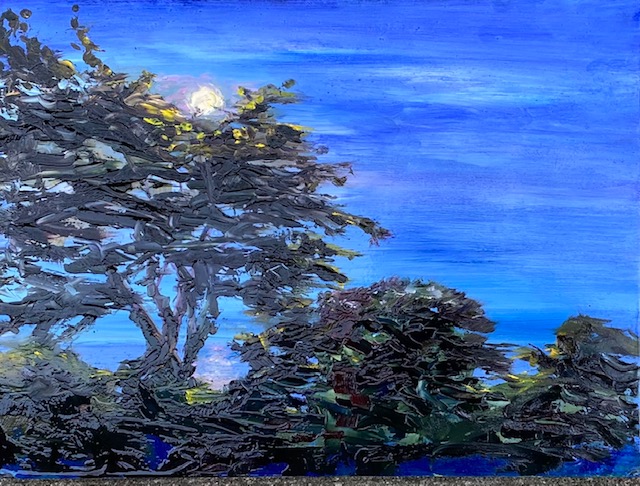
Nocturnes: Painting Safety for Artists at Night
There was a night in mid-October 2021, when in T-shirt and jeans I painted a full moon rising above a lacey tree over the Lake Michigan. For me, it was a highlight of painting experiences. I was painting without a buddy, but felt comfortable in the park until I realized the voices from the park bench near the entrance had ceased.
I was completely alone and it was pitch black outside the arched glow of my orchestra light on my easel. At one point, as I reached over to the picnic table that held by brushes, my eye caught movement behind me. My heart and adrenaline blasted.
Turns out, it was moon shadows dancing on a tree that I didn’t realize was behind me. Fear explodes when you least expect it. Nocturnes set the stage for our perception of danger and for the dangerous to come out. Here are a couple thoughts specifically about painting at night.
- This is the best time to paint with a buddy.
- Plan your nocturnes for those months with the shortest days. Set up and block in 30 minutes prior to sunset. You can start during rush hour and end before traffic has completely diminished.
- It may be late as you finish a nocturne. Before you go, make sure you’ve checked public transportation schedules and closing time for the places you view as safe havens and parking garages.
Health and Safety for Artists
Besides the external threats discussed here, I would be remiss not mention the dangers we pose to ourselves while painting. I’m not going to go into detail, but will simply remind you to wear sunscreen, stay hydrated, and wear a hat and glasses with UV coatings, which according to the American Academy of Ophthalmology, “are as effective as those on sunglasses.”
Further, industrial health specialists identify three ways our pigments and mediums may find a path to hurt us, through inhalation. It’s less of an issue outside, but absorption through the skin and ingestion are possible: don’t eat with paint on your hands or dip your brush into your coffee cup.
There was a time before I became a painter that I was trained as a health educator, and get this, was “Healthy Mary” on a children’s television show with a hippie puppet, who mostly said, “Heavy, Dude.” I am honored to be asked to resurface those interests for you. If you have additional ideas, please let us know by sharing them in the comments section below.
And, don’t forget to watch out for invisible Japanese monsters when you’re painting.
Related Articles:
PleinAir Podcast 183: Mary Longe Shares Advice for Starting a Plein Air Group
How to Start a Plein Air Group, Part 1
We often hear of successful plein air painting societies and associations, but what if you don’t live … [read more about how to start a plein air group]
Visit EricRhoads.com to find out all the amazing opportunities for artists through Streamline Publishing, including:
– Online art conferences such as Plein Air Live
– New video workshops for artists
– Incredible art retreats
– Educational and fun art conventions, and much more.
> Subscribe to Plein Air Today, a free newsletter for artists
> Subscribe to Plein Air Magazine so you never miss an issue

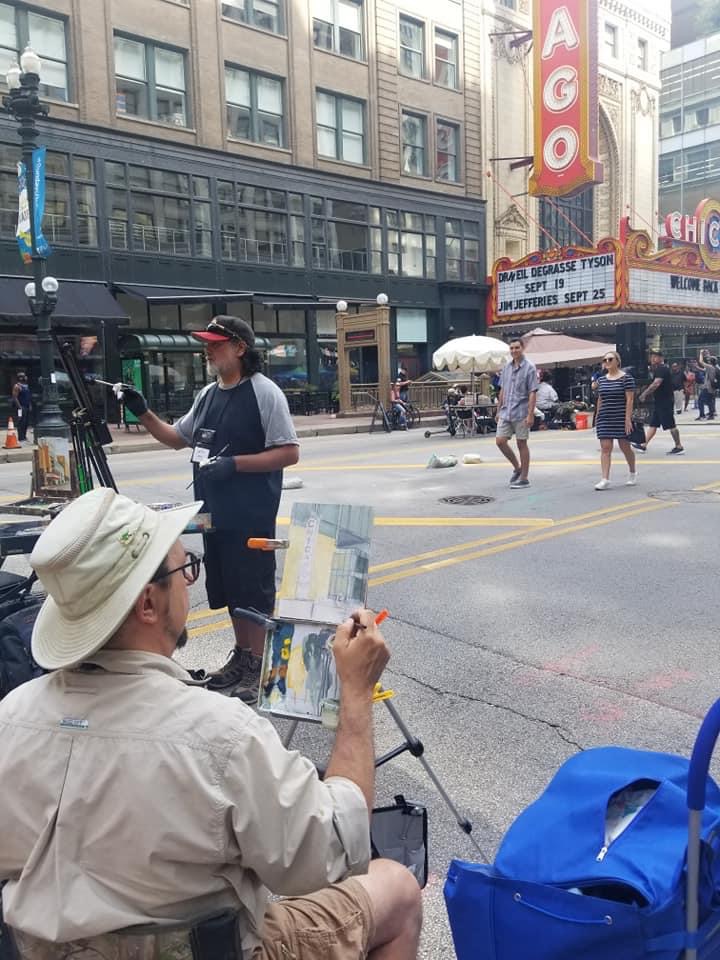

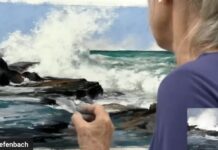
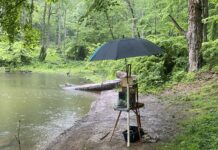

Helpful tips in this article. Especially important for women. I often go out on my own to paint so need to be prepared.
Very good advice! I appreciated the details, hypothetical situations, and suggestions to consider.
Thank you!
Thank you for these suggestions. With respect to health considerations, I’d like to know which pigments are of the greatest concern and of these pigments, are their good alternatives?
Great article! Lots of good information.
Thank you,
Jill